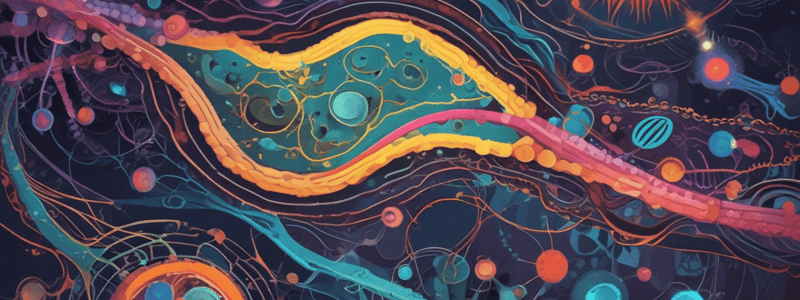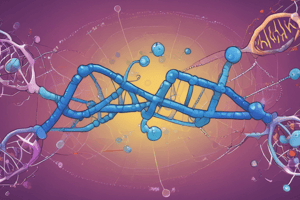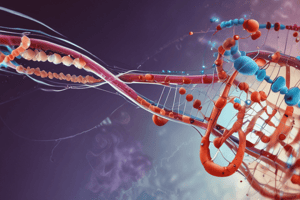Podcast
Questions and Answers
What is the primary function of RNA polymerase in transcription?
What is the primary function of RNA polymerase in transcription?
- To add nucleotides to the growing RNA chain (correct)
- To read the template strand in the 3' to 5' direction
- To recognize the terminator sequence
- To unwind the DNA double helix
What is the name of the RNA molecule produced during transcription in eukaryotic cells?
What is the name of the RNA molecule produced during transcription in eukaryotic cells?
- rRNA
- mRNA
- pre-mRNA (correct)
- tRNA
What is the function of the promoter sequence in transcription?
What is the function of the promoter sequence in transcription?
- To terminate transcription
- To recognize where to start transcription (correct)
- To unwind the DNA double helix
- To add nucleotides to the growing RNA chain
In which direction does RNA polymerase read the template strand during transcription?
In which direction does RNA polymerase read the template strand during transcription?
What is the name of the enzyme responsible for transcribing DNA into RNA?
What is the name of the enzyme responsible for transcribing DNA into RNA?
What is the function of the terminator sequence in transcription?
What is the function of the terminator sequence in transcription?
What is the purpose of the 5' cap in mRNA processing?
What is the purpose of the 5' cap in mRNA processing?
What is the purpose of splicing in mRNA processing?
What is the purpose of splicing in mRNA processing?
What is the function of the spliceosome?
What is the function of the spliceosome?
What is the final product of mRNA processing?
What is the final product of mRNA processing?
What is the function of the poly-A tail?
What is the function of the poly-A tail?
What is the purpose of the hairpin loop in transcription termination?
What is the purpose of the hairpin loop in transcription termination?
Flashcards are hidden until you start studying
Study Notes
Transcription Process
- Transcription is the process of creating a complementary RNA copy from a DNA template.
- The transcriptase enzyme reads the DNA template and adds nucleotides to a growing RNA chain.
- In eukaryotic cells, transcription occurs in the nucleus, and the resulting RNA is called pre-mRNA.
- The pre-mRNA undergoes processing to become mature mRNA, which can then leave the nucleus and be translated into protein.
Initiation of Transcription
- The process of transcription begins with the binding of an enzyme called RNA polymerase to a specific DNA sequence called a promoter.
- The promoter acts as a binding site for RNA polymerase, allowing it to recognize where to start transcription.
- Each gene has its own promoter sequence, and some genes may have multiple promoters.
Elongation of Transcription
- Once RNA polymerase has bound to the promoter, it begins to unwind the DNA double helix and transcribe the template strand.
- The RNA polymerase reads the template strand in the 5' to 3' direction, adding nucleotides to the growing RNA chain.
- The process of transcription is similar to DNA replication, with the exception that RNA polymerase only adds nucleotides to the 3' end of the RNA chain.
Termination of Transcription
- Transcription is terminated when the RNA polymerase reaches a specific DNA sequence called a terminator.
- The terminator acts as a signal for the RNA polymerase to stop transcription.
- There are several ways in which the terminator can signal the RNA polymerase to stop, including the formation of a hairpin loop that prevents further transcription.
Processing of pre-mRNA
- In eukaryotic cells, the pre-mRNA undergoes processing to become mature mRNA.
- This processing involves the addition of a 5' cap and a poly-A tail to the pre-mRNA.
- The 5' cap is a modified guanine nucleotide that helps to protect the mRNA from degradation and aids in translation.
- The poly-A tail is a long sequence of adenine nucleotides that helps to stabilize the mRNA and promote translation.
Splicing of pre-mRNA
- In eukaryotic cells, the pre-mRNA may contain introns, which are sequences that do not code for protein.
- These introns are removed from the pre-mRNA through a process called splicing, leaving behind exons that are joined together to form the mature mRNA.
- The splicing process is carried out by a complex of enzymes called the spliceosome.
Final mRNA Product
- The final mRNA product is a mature, processed RNA molecule that is ready to be translated into protein.
- The mRNA molecule is composed of exons that are joined together, and is capped with a 5' cap and a poly-A tail.
- The mature mRNA is then transported out of the nucleus and into the cytoplasm, where it is translated into protein by the ribosome.
Transcription Process
- Transcription is the process of creating a complementary RNA copy from a DNA template.
- The transcriptase enzyme reads the DNA template and adds nucleotides to a growing RNA chain.
Initiation of Transcription
- The process of transcription begins with the binding of RNA polymerase to a specific DNA sequence called a promoter.
- The promoter acts as a binding site for RNA polymerase, allowing it to recognize where to start transcription.
- Each gene has its own promoter sequence, and some genes may have multiple promoters.
Elongation of Transcription
- RNA polymerase unwinds the DNA double helix and transcribes the template strand in the 5' to 3' direction.
- RNA polymerase adds nucleotides to the growing RNA chain, similar to DNA replication, but only adds nucleotides to the 3' end of the RNA chain.
Termination of Transcription
- Transcription is terminated when the RNA polymerase reaches a specific DNA sequence called a terminator.
- The terminator acts as a signal for the RNA polymerase to stop transcription.
- The terminator can signal the RNA polymerase to stop through the formation of a hairpin loop that prevents further transcription.
Processing of pre-mRNA
- In eukaryotic cells, the pre-mRNA undergoes processing to become mature mRNA.
- Processing involves the addition of a 5' cap and a poly-A tail to the pre-mRNA.
- The 5' cap is a modified guanine nucleotide that helps protect the mRNA from degradation and aids in translation.
- The poly-A tail is a long sequence of adenine nucleotides that helps stabilize the mRNA and promote translation.
Splicing of pre-mRNA
- In eukaryotic cells, the pre-mRNA may contain introns, which are sequences that do not code for protein.
- Introns are removed from the pre-mRNA through a process called splicing, leaving behind exons that are joined together to form the mature mRNA.
- The splicing process is carried out by a complex of enzymes called the spliceosome.
Final mRNA Product
- The final mRNA product is a mature, processed RNA molecule that is ready to be translated into protein.
- The mRNA molecule is composed of exons that are joined together, and is capped with a 5' cap and a poly-A tail.
- The mature mRNA is then transported out of the nucleus and into the cytoplasm, where it is translated into protein by the ribosome.
Studying That Suits You
Use AI to generate personalized quizzes and flashcards to suit your learning preferences.



